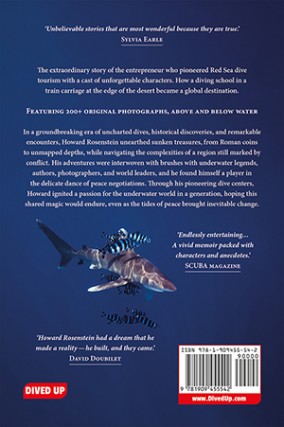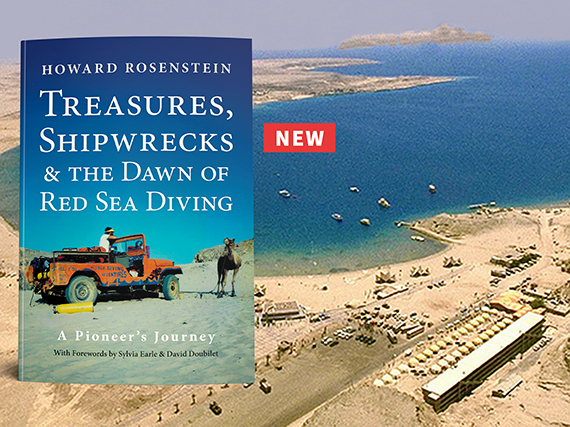Book review: Treasures, Shipwrecks and the Dawn of Red Sea Diving
Sinai tourism pioneer shares a lifetime of memories
The dive industry in Egypt’s Sinai peninsula is mature and extensive, but it hasn’t always been so.
Tourism pioneer Howard Rosenstein was first on the scene back in the late 1960s, and saw the potential of the area even though Egypt and Israel had only recently finished fighting. In his new book ‘Treasures, Shipwrecks and the Dawn of Red Sea Diving’ Howard delves into his memory banks to share a lifetime of memories, from an era that was the beginnings of Red Sea diving tourism as we know it today.
The new book, which is on sale in paperback by Dived Up Publications, is a kaleidoscope of events that is kick started following a trip from the US to Israel to study at Tel Aviv university in 1968. During his downtime Howard took up snorkelling to recover coins in the waters of ancient Caesareum, at a time when antiquities weren’t regulated and were a steady source of cash. The mixture of history, underwater excitement and a clear propensity for entrepreneurship was setting the path forward for the young Howard at a time when scuba diving was in its infancy. In short order he had opened a dive centre in Gaza on the Mediterranean.
 The focus of the book soon shifts to the Sinai, an area of land between the Gulf of Suez in the west and Gulf of Aqaba in the east. In the early 1970s this was little more than open desert and mountains, with Bedouin fishermen the only locals, where there were any at all. The author recounts that with his commercial senses awakened he and his girlfriend soon-to-be wife Sharon cajoled, bartered, begged and borrowed their way to establishing a dive centre in Sharm El Sheikh, that boasted little more than an old WW1-era train carriage and a compressor.
The focus of the book soon shifts to the Sinai, an area of land between the Gulf of Suez in the west and Gulf of Aqaba in the east. In the early 1970s this was little more than open desert and mountains, with Bedouin fishermen the only locals, where there were any at all. The author recounts that with his commercial senses awakened he and his girlfriend soon-to-be wife Sharon cajoled, bartered, begged and borrowed their way to establishing a dive centre in Sharm El Sheikh, that boasted little more than an old WW1-era train carriage and a compressor.
The world of a half-century ago was still discovering the sport of scuba diving. Unlike the resorts boasting every comfort of modern tourism that exist there today, diving operations were carried out from the carriage using rudimentary dive boats, vehicles and equipment – although the one hotel that was created in Sharm El Sheikh quickly became a popular magnet for Israeli tourists.
What comes across in Howard’s account, nicely told, is how ‘hot’ the region was at the time. There are regular and ongoing interactions with the Egyptian and Israeli militaries, particularly in the years following the Yom Kippur war in 1973. Most military personnel he seems to have come up against were seemingly sympathetic to his dive outfit, and invariable ended up helping him in one way or another – perhaps bemused by this bunch of oddballs goofing around in the Red Sea with scuba.
Rosenstein’s reputation became large enough to attract celebrities too, and he recalls many visits from and dives with David and Anne Doubilet (celebrated underwater photographers) and Dr Genie Clarke, together working on behalf of National Geographic. Naturally, the resulting footage was spectacular and no doubt helped cement Red Sea diving firmly into the public consciousness.
Reading the book gives you a sense that Howard struggled with deciding what to leave out, as much as what to include. In its 200-odd pages he documents the full spectrum of dive tourism in the Sinai, often with laugh-out-loud anecdotes and with plenty of self-modesty too. As a true pioneer of an industry we modern divers take for granted, it would be easy for the book to come across as ‘it was better in the olden days’ kind of war story, though the author has helpfully managed to avoid this trap.
What is certainly true is that the Sinai area has been in tumult for many of the years since Red Sea Divers (the name of Howard’s business) came into being in the 1970s, and his foresight laid much of the groundwork for diving in the area today. For example, he quickly realised that a shipwreck was desperately needed to draw tourists in, although there was only one problem: not a single one was known about! The book recounts how Howard and his team set about speaking to local Bedouin fishermen (with suitable bribes) to discover where they were fishing offshore, which in time revealed a mysterious wreck out beyond Ras Mohammed. I won’t reveal which one this turned out to be, suffice to say it’s an absolute classic and will be well known to most scuba divers who have dived in the Red Sea…
By the 1980s and after a 25-year run Egypt and Israeli agreed a new treaty, which meant a withdrawal from Sinai for Israeli citizens including Howard and his family. Although this isn’t the end of his story, as he explains how this led to a new venture running liveaboard boats in the Red Sea and beyond, which is of course how many divers experience the beautiful reefs nowadays.
‘Treasures, Shipwrecks and the Dawn of Red Sea Diving’ has the word ‘pioneer’ on the front cover and in Howard’s case, it is true: he has fitted more into his 70-plus years than many of us would manage in half a dozen lifetimes. There are many books about history on the shelves of diving enthusiasts, but not so many about the history of diving – and certainly not the history of diving tourism. This book rights that wrong, and it is long overdue.
The next time you are diving in Sharm El Sheikh and wonder at the spectacular reefs, just imagine young Howard was doing it in the early 1970s with only the Israeli military for company. And the sharks of course…
Treasures, Shipwrecks and the Dawn of Red Sea Diving by Howard Rosenstein is available now direct from Dived Up Publications and other book retailers, priced £25 RRP.

Book review – Shipwrecks of the Dover Straits
World’s busiest shipping lane is a mecca for scuba divers

Book review – Scuba Diving Operational Risk Management
Risk is something all diving agencies train divers to plan for every time they enter the water






